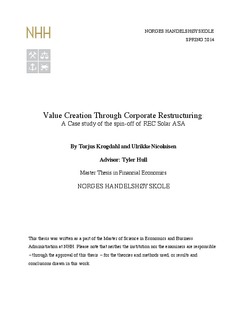Value creation through corporate restructuring : a case study of the spin-off of REC Solar ASA
Master thesis
Permanent lenke
http://hdl.handle.net/11250/223273Utgivelsesdato
2014Metadata
Vis full innførselSamlinger
- Master Thesis [4372]
Sammendrag
This thesis presents a detailed analysis of the spin-off in REC ASA to show how corporate
reorganization can enhance the value of a firm operating in a challenging industry. The goal of
the study was to determine whether the separation of REC ASA’s module and polysilicon units
generated value and, if it did, what the sources were. The research followed a funneling approach,
where the initial research fathomed broadly before singling out the most important aspects of the
transaction. This included an analysis of empirically proven value drivers, industry and firm
specific factors, before ending with a thorough analysis of the key characteristics of the
transaction.
The study finds that the spin-off generated an abnormal return of 19.53 percent immediately
following the announcement, while the longer event windows were affected by conflicting
announcements making the abnormal return output unreliable. The announcement was also
associated with a positive reaction in bond prices, establishing that the separation was value
enhancing also for the debt holders. The analysis of value drivers shows that the company was
trading at a relative discount prior to the spin-off and that the discount was eliminated following
the announcement. The key value driver in the transaction was that it solved the firm’s cash
shortage problem by bringing its cash balance in excess of its short debt maturities. In addition, it
improved the strategic position of both parent and subsidiary by eliminating the silicon unit’s
exposure to the underperforming solar unit and positioning the solar unit for the expected
challenges of the module industry.
